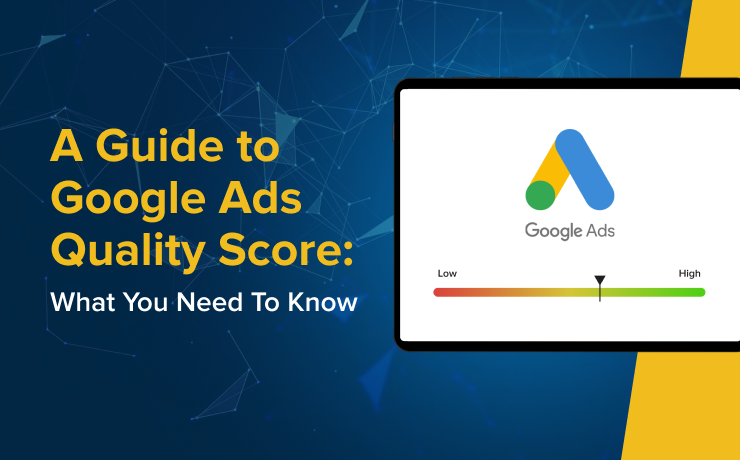A Guide to Google Ads Quality Score: What You Need To Know

Chad Faith
Director of Content

Google Ads Quality Score is a critical metric that impacts the effectiveness and cost-efficiency of your PPC campaigns. Understanding how it works can significantly enhance your advertising performance. Let’s uncover the different aspects of Google Ads Quality Score and offer actionable tips to improve it.
Types of Quality Score
Account-Level Quality Score
Account-level Quality Score is influenced by the historical performance of all the keywords and ads within your account. While Google doesn’t officially confirm this metric, it is widely believed that an account’s overall performance history affects individual keyword scores. If your account contains many low-quality keywords and ads with poor click-through rates (CTR), it can drag down your overall Quality Score, making it harder to introduce new keywords effectively.
To maintain a high account-level Quality Score, it’s essential to audit and optimize your account regularly. This involves pausing or deleting underperforming keywords and ads, restructuring campaigns, and ensuring relevance across all components of your ads.
Ad Group Quality Score
Ad group-level Quality Score provides insights into which specific areas within a campaign need improvement. This score is an average of the keyword Quality Scores within each ad group. Focusing on improving the ad groups with the lowest average scores first can yield significant benefits for your overall campaign performance.
Restructuring your ad groups for better relevance, enhancing ad copy, and removing low-CTR ads can help boost the Quality Score at this level. Although ad group Quality Scores aren’t directly visible in the interface, their impact on your campaigns is substantial.
Keyword-Level Quality Score
The keyword-level Quality Score is visible within the Google Ads interface and is rated on a scale from 1 to 10. This score reflects how relevant your keywords are based on past performance data from search queries that match your keywords exactly. It’s crucial to note that new keywords will inherit their initial Quality Scores based on historical data until they accumulate enough impressions to generate their own performance data.
To improve keyword-level Quality Scores, focus on creating highly relevant ad copy and landing pages that match the user’s search intent. Monitoring metrics like ad relevance, landing page experience, and expected CTR can provide valuable insights into areas needing improvement.
Ad-Level Quality Score
The performance of your ads directly influences their Quality Scores. Ads with higher CTRs generally receive better scores, as they indicate relevance to the user’s search query. Utilizing Dynamic Keyword Insertion (DKI) can be a powerful tactic to enhance ad relevance, though it must be used carefully to avoid irrelevant matches.
Regularly review and optimize your ad copy to ensure it remains engaging and relevant to your target audience. Pausing underperforming ads can also help maintain a higher overall Quality Score without negatively impacting your account.
Landing Page Quality Score
Google emphasizes the importance of landing page quality in its Quality Score calculations. Factors such as relevant and original content, transparency, and ease of navigation are critical. Ensuring that your landing pages provide a positive user experience will not only improve your Quality Scores but also enhance your conversion rates.
Conduct regular audits of your landing pages to ensure they meet Google’s quality standards. Fast load times, mobile responsiveness, and clear calls to action are essential elements of a high-quality landing page.
Display Network Quality Score
Quality Scores on the Google Display Network (GDN) operate differently from the Search Network. Here, the score is influenced by the historical performance of your ads on similar sites and their relevance to the site content. Depending on your bidding strategy, different factors may come into play.
To optimize your GDN Quality Scores, experiment with different ad formats and closely monitor performance metrics such as relative CTR. Tailoring your ads to specific sites and demographics can help improve their effectiveness and overall Quality Score.
Tips to Improve Your Google Ads Quality Score
- Audit and Optimize Regularly: Conduct periodic audits of your account to identify underperforming keywords and ads. Regular optimization helps maintain high relevance and performance.
- Enhance Ad Relevance: Ensure your ad copy closely matches the keywords and search queries you are targeting. Use Dynamic Keyword Insertion judiciously.
- Improve Landing Page Experience: Focus on providing high-quality, relevant content on your landing pages. Ensure they are easy to navigate and load quickly.
- Monitor Performance Metrics: Keep a close eye on metrics such as CTR, ad relevance, and landing page experience to identify areas for improvement.
- Use Appropriate Match Types: Avoid overly restrictive match types that limit impressions. Consider broader match types where appropriate to increase visibility.
Understanding and optimizing your Google Ads Quality Score is essential for running successful PPC campaigns. Consider our Google Ads management services for expert assistance with managing your Google Ads campaigns. At SmartSites, we specialize in maximizing your advertising potential through tailored digital marketing strategies and expert insights.
 Free
Consultation
Free
Consultation Free
Google Ads Audit
Free
Google Ads Audit







